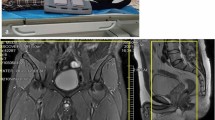Abstract
Objective
Agreement rate between magnetic resonance imaging (MRI) and Doppler ultrasound (DUS) for the detection of deep vein thrombosis (DVT) in the lower extremities was attempted by using the intravascular MRI contrast agent gadofosveset trisodium. The potential of this method to detect pulmonary embolism (PE) was also evaluated.
Material and Methods
Forty-three consecutive inpatients with ultrasound-confirmed DVT but no clinical signs of PE were prospectively enrolled in this feasibility study. MRI was performed after a single injection of gadofosveset trisodium. The pulmonary arteries were imaged using a 3D Fast Low Angle Shot (FLASH) gradient recalled echo sequence. Additionally, pulmonary arteries, abdominal veins, pelvic and leg veins were imaged using a fat-suppressed 3D gradient echo Volume Interpolated Breath-hold Examination (VIBE FS).
Results
Gadofosveset trisodium-enhanced MRI detected more thrombi in the pelvic region, upper leg and lower leg than the initial DUS. In addition, PE was detected in 16 of the 43 DVT patients (37%).
Conclusion
This study shows the feasibility of a combined protocol for the MRI diagnosis of DVT and PE using gadofosveset trisodium. This procedure is not only more sensitive in detecting DVT compared to standard DUS, but is also able to detect PE in asymptomatic patients.





Similar content being viewed by others
References
Gaitini D (2007) Multimodality imaging of the peripheral venous system. Int J Biomed Imaging 2007:54616
Cushman M (2007) Epidemiology and risk factors for venous thrombosis. Semin Hematol 44:62–69
Cohen AT, Agnelli G, Anderson FA et al (2007) Venous thromboembolism (VTE) in Europe. The number of VTE events and associated morbidity and mortality. Thromb Haemost 98:756–764
Goodacre S, Sampson F, Thomas S, van Beek E, Sutton A (2005) Systematic review and meta-analysis of the diagnostic accuracy of ultrasound for deep vein thrombosis. BMC Med Imaging 5:6
Gulsun Akpinar M, Goodman LR (2008) Imaging of pulmonary thromboembolism. Clin Chest Med 29:107–116
Eichinger S (2005) Treatment of venous thromboembolism. Wien Med Wochenschr 155:7–10
Kroegel C, Reissig A (2003) Principle mechanisms underlying venous thromboembolism: epidemiology, risk factors, pathophysiology and pathogenesis. Respiration 70:7–30
Sampson FC, Goodacre SW, Thomas SM, van Beek EJ (2007) The accuracy of MRI in diagnosis of suspected deep vein thrombosis: systematic review and meta-analysis. Eur Radiol 17:175–181
Kluge A, Muller C, Hansel J, Gerriets T, Bachmann G (2004) Real-time MR with TrueFISP for the detection of acute pulmonary embolism: initial clinical experience. Eur Radiol 14:709–718
Rohrer M, Bauer H, Mintorovitch J, Requardt M, Weinmann HJ (2005) Comparison of magnetic properties of MRI contrast media solutions at different magnetic field strengths. Invest Radiol 40:715–724
Goyen M (2008) Gadofosveset-enhanced magnetic resonance angiography. Vasc Health Risk Manag 4:1–9
Killewich LA, Bedford GR, Beach KW, Strandness DE Jr (1989) Diagnosis of deep venous thrombosis. A prospective study comparing duplex scanning to contrast venography. Circulation 79:810–814
Habscheid W (1997) Die tiefe Venenthrombose: Bedeutung der Kompressionssonographie. Dtsch Arztebl 94:2141
Nazaroglu H, Ozmen CA, Akay HO, Kilinc I, Bilici A (2009) 64-MDCT pulmonary angiography and CT venography in the diagnosis of thromboembolic disease. AJR Am J Roentgenol 192:654–661
Walsh G, Redmond S (2002) Does addition of CT pelvic venography to CT pulmonary angiography protocols contribute to the diagnosis of thromboembolic disease? Clin Radiol 57:462–465
Begemann PG, Bonacker M, Kemper J et al (2003) Evaluation of the deep venous system in patients with suspected pulmonary embolism with multi-detector CT: a prospective study in comparison to Doppler sonography. J Comput Assist Tomogr 27:399–409
Rademaker J, Griesshaber V, Hidajat N, Oestmann JW, Felix R (2001) Combined CT pulmonary angiography and venography for diagnosis of pulmonary embolism and deep vein thrombosis: radiation dose. J Thorac Imaging 16:297–299
Oudkerk M, van Beek EJ, Wielopolski P et al (2002) Comparison of contrast-enhanced magnetic resonance angiography and conventional pulmonary angiography for the diagnosis of pulmonary embolism: a prospective study. Lancet 359:1643–1647
Ley S, Kauczor HU, Heussel CP et al (2003) Value of contrast-enhanced MR angiography and helical CT angiography in chronic thromboembolic pulmonary hypertension. Eur Radiol 13:2365–2371
Pedersen MR, Fisher MT, van Beek EJ (2006) MR imaging of the pulmonary vasculature—an update. Eur Radiol 16:1374–1386
Kearon C (2003) Natural history of venous thromboembolism. Circulation 107:I22–30
Acknowledgements
The authors thank Dr. Hartmut Burmeister and Dr. Michael Deutschmann for supervision of some MRI examinations and Dr. Ernesta Palombo-Kinne for critical revision of the manuscript.
Author information
Authors and Affiliations
Corresponding author
Electronic supplementary material
Below is the link to the electronic supplementary material.
Movie 1
MRI of the lower extremity (3D volumetric interpolated breath-hold sequence (VIBE) with fat suppression; TR/TE, 4.1/1.4) showing a thrombus in the left superficial femoral vein and popliteal vein. (MPG 3928 kb)
Movie 2
MRI of the lung (3D Fast Low Angle Shot (FLASH) gradient recalled echo sequence, TR/TE: 2.7 ms/2.4) depicting a large embolus in the left pulmonary artery (arrow). Note the solitary, sharp-edged round liver lesion in the right lobe with cystic appearance (arrowhead). (MPG 5803 kb)
Rights and permissions
About this article
Cite this article
Hansch, A., Betge, S., Poehlmann, G. et al. Combined magnetic resonance imaging of deep venous thrombosis and pulmonary arteries after a single injection of a blood pool contrast agent. Eur Radiol 21, 318–325 (2011). https://doi.org/10.1007/s00330-010-1918-0
Received:
Revised:
Accepted:
Published:
Issue Date:
DOI: https://doi.org/10.1007/s00330-010-1918-0




